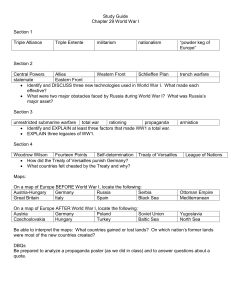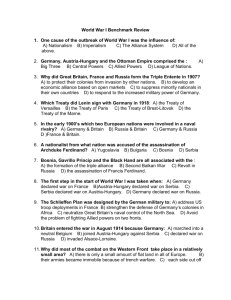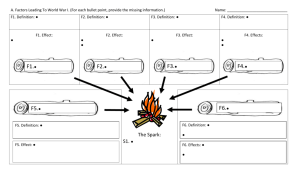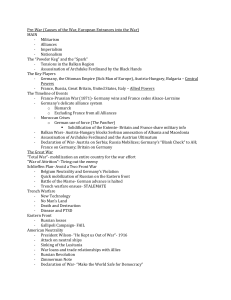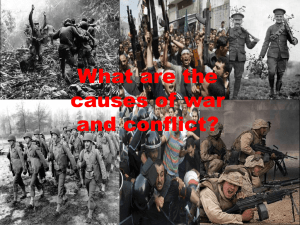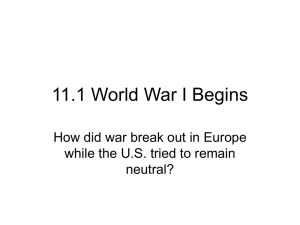Ch. 29: The Great War - Bismarck Public Schools
advertisement
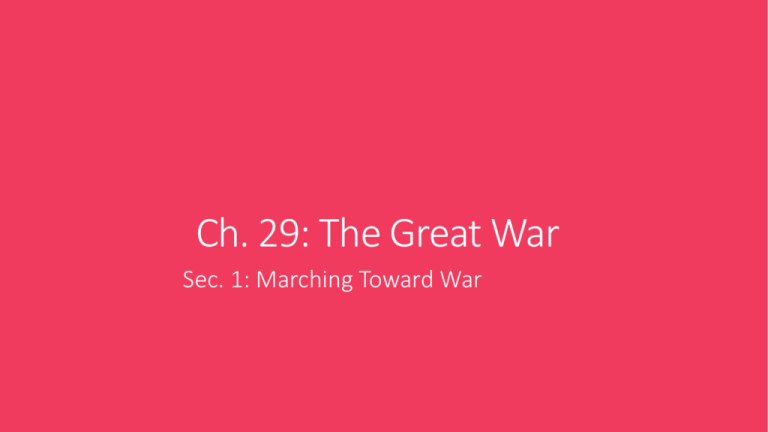
Ch. 29: The Great War Sec. 1: Marching Toward War Background - By 1900, most of Europe had been at peace for nearly 30 years. Many peace organizations were active and some Europeans believed that the progress gained had made war a thing of the past. But beneath all of the goodwill, tensions were rising. Nationalism – A deep devotion to one’s country - Nationalism can serve as a unifying force but it can cause intense competition among nations with each seeking to overpower the other. - Rivalries had developed between the European powers of Austria – Hungary, France, Great Britain, Germany, and Italy Causes 1. Competition for minerals 2. Competition for markets 3. Territorial disputes (France losing the Alsace-Lorraine region to Germany in the Franco-Prussian War in 1870) 4. Imperialism 5. Arms Race Build up Arms race – The need for advanced weapons and large armies Militarism – Glorifying military power - Read primary source p. 842 - Growing rivalries and mistrust led to the creation of alliances. Alliances are designed to maintain peace, but they actually did the opposite Arms race Alliances - Germany felt France was the biggest threat to peace so they created alliances that would isolate France Triple Alliance – An alliance between Germany, AustriaHungary, and Italy - Germany also created a separate alliance with Russia Kaiser Wilhelm Kaiser Wilhelm – Takes control of Germany in 1890 and lets the alliance with Russia lapse. - He also decided to build a strong navy to compete with Great Britain - The British didn’t like the Kaiser’s actions so they formed an entente (alliance) Triple Entente Triple Entente – An alliance between Great Britain, Russia, and France - A dispute between any of the European powers could draw all of them into war Balkans Balkan Peninsula – A region in southeast Europe. It comprised several ethnic groups and had a history of uprisings. - It had been referred to as the “powder keg” of Europe - Most of the Balkan countries were under the Ottoman Empire but as that was collapsing, several had gained independence (Greece, Bulgaria, Romania, Montenegro, Serbia) Serbia - Serbia wanted to expand its borders to create a large Slavic state and Russia supported them - Austria-Hungary opposed Serbia’s plan fearing it would create Slavic nationalism in its lands Tension - In 1908, Austria-Hungary annexed Bosnia and Herzegovina. This upset Serbia who also wanted that region and vowed to get it. This created tension between Serbia and Austria-Hungary Assassination June 28, 1914 – Archduke Franz Ferdinand (heir to the AustroHungarian throne) and his wife Sophie are assassinated in Sarajevo (Bosnia) by a Serbian national while on a state visit. - As a result, Austria-Hungary declared war on Serbia and Russia, an ally of Serbia, declared war on Austria-Huungary Sec. 2: Europe Plunges into War War - By 1914 Europe was divided into two main camps: Triple Entente – Great Britain, France, Russia Triple Alliance – Austria-Hungary, Germany, Italy - Because of their pledge to support each other, nearly all of Europe went to war War Central Powers – Germany and Austria-Hungary. So called because they are located in central Europe. They were later joined by the Ottomans and Bulgaria Allies – Great Britain, France, and Russia. Eventually they were joined by Japan and Italy (who switched sides) - By the fall of 1914 the sides were deadlocked. No one was gaining an advantage Fronts Western Front – The battle lines in northern France Eastern Front – The battle lines along the German-Russian border Schlieffen Plan – Germany’s plan for a quick victory over France in the west, and then sending its troops to the east to defeat Russia Stalemate - At first it looked like the plan might work but the allies regrouped and pushed Germany back in the west - The western front became a stalemate - Germany was now faced with fighting a war on two fronts - The tactic used during WWI was called Trench Warfare Trench Warfare Trench Warfare – Soldiers fought each other from trenches, trading huge loss of human life for small gains in land Read: Trench Warfare p. 847-848 - The war in the east was mostly Germany and Austria-Hungary vs Russia and Serbia. The east was more mobile, but slaughter and stalemates were common here too. Trench Warfare War - Russia had not yet industrialized so the war was more difficult. Russia was always short of supplies and supply lines were iffy. - Russia did have huge numbers however. Russia suffered huge battlefield losses but they were able to tie up millions of German soldiers in battle preventing them from helping in the west The Great War eventually spread to Africa and Southeast Asia becoming a true world war Sec. 3: A Global Conflict Gallipoli - As the stalemates continued, both sides looked for new alliances. They also looked for new battle fronts to gain victory The Gallipoli Campaign (February, 1915) – The allies attempted to take the Dardanelles (a waterway) and the Gallipoli peninsula Doing so would cut off the Ottoman capital and create a supply line to Russia Stalemate - Soon this campaign also became a trench warfare stalemate. By December 1915, the allies gave up and evacuated - Japan attacked German colonies in China and the Pacific hoping to cut off supplies and possibly gain some territory for themselves Africa - The British and the French recruited their subjects in Africa to help take Germany’s African colonies. - Some of the colonies helped thinking it might lead to their independence and others had no interest in the colonizer’s war U Boat - Germany had an advantage in submarine warfare and used it to sink supply ships May 7, 1915 – Germany sinks the Lusitania, a British passenger ship. 1,198 people died including 128 Americans - The ship had been carrying ammunition, but the American public was still outraged Lusitania - Germany backed off on the attacks for a while Unrestricted submarine warfare – Declared by Germany in January, 1917. The would sink, without warning, any ship in the waters around Britain - 3 American ships were sunk as a result Zimmerman Telegram Zimmerman Telegram – A note sent by German foreign secretary Arthur Zimmerman to Mexican officials asking them to join Germany in exchange for land lost to America in the Mexican-American War - This proved to be the last straw. The US declared war on Germany on April 2, 1917. - By the time the US got involved, the Great War had been raging for 3 years and millions had been killed Total War Total War – Devoting all resources to the war effort - Most factories were taken over by the government and manufactured supplies for the war Rationing – People could buy only small amounts of goods that were also needed for the war (butter, food supplies, leather, rubber, etc) Propaganda - The government often censored the news fearful that the truth would turn support against the war Propaganda – One-sided information designed to persuade and keep up morale and support for the war - Women were also recruited in the war effort. Many replaced the men in factories that had gone off to war. They performed traditionally “male” jobs Propaganda Propaganda Russia - US entry into the war gave the allies a huge advantage, however problems in Russia changed that. - An uprising in Russia caused them to pull out of the Great War in November, 1917. Russia then signed a peace treaty with Germany. This essentially ended the war in the east. - Germany was now able to send nearly all troops to the western front - Germany launched an all out assault on Paris and got to within 40 miles - But with 2 million fresh American soldiers helping out, the allies pushed the Germans back and the Central Powers began to collapse. The End of the War - First the Bulgarians surrendered, and then the Ottomans October 1918 – Revolution swept through Austria-Hungary and soon Germany was alone. November 9, 1918 – Kaiser Wilhelm steps down, Germany is declared a republic, and Germany signed an armistice with the French The End of the War Armistice – An agreement to stop fighting November 11, 1918 – The war officially ended Armistice Great War Legacy: 1. Ushered in the notion of war on a global scale 2. It left 8.5 million soldiers dead (116,000 Americans) and 21 million wounded 3. Countless civilian deaths 4. It drained the treasuries of those involved (338 billion – a huge amount at the time Damage 5. It destroyed many homes and thousands of acres of farmland 6. It created a bad war-ending treaty Sec. 4: A Flawed Peace Treaty - On January 18, 1919 a conference began which was to establish the terms of peace. It would take a year and much bitter debate. Each country had a view on what terms would be best. 32 nations sent representatives to the conference. Neither Germany nor its allies were represented - Due to a civil war, Russia was not represented either - Despite all of the representatives, most of the decisions were made by the “Big 4” Big 4 1. Woodrow Wilson – USA 2. Georges Clemenceau – France 3. David Lloyd George – Great Britain 4. Vittorio Orlando – Italy 14 Points Fourteen Points – Wilson’s proposal for peace terms - the guiding idea behind these points was self-determination Self-Determination – Allowing people to decide for themselves under which government they wished to live Stuff - Wilson also called for a League of Nations that would represent great and small nations alike. He hoped that this organization could negotiate a peaceful solution to world conflicts June 28, 1919 – The treaty is signed (by most nations….) Treaty of Versailles – The treaty that ended the Great War The treaty was very tough on Germany Treaty Terms 1. Germany had restrictions placed on its military 2. Germany lost much of its land in Europe and all of its colonies (they became mandates) 3. War Guilt Clause – It placed sole responsibility for the war on Germany and forced Germany to pay reparations Reparations Reparations – payment for war damages - The treaty created feelings of bitterness among the victors and the defeated Treaty Unhappy Compromise – refers to the Treaty of Versailles New Map - Several new nations were created out of land lost by the Central Powers Austria-Hungary – Austria, Hungary, Czechoslovakia, Yugoslavia Ottoman Empire – Turkey, Palestine, Iraq, Jordan, Syria, Lebanon Russia – Poland, Finland, Romania, Estonia, Latvia, Lithuania Bitterness - The treaty did not build lasting peace. It was just the opposite - America rejected the treaty and signed a separate peace with Germany in later years - America did not join the League of Nations and it ultimately failed - Japan and Italy were bitter about not getting the land they desired - Imperialism didn’t really end it just continued under the mandate system Bitterness - The War Guilt Clause left a bitter hatred with the Germans and left the country impoverished and starved for new leadership - The treaty has been called a “treaty built on quicksand” - The treaty would lead to another war THE END
